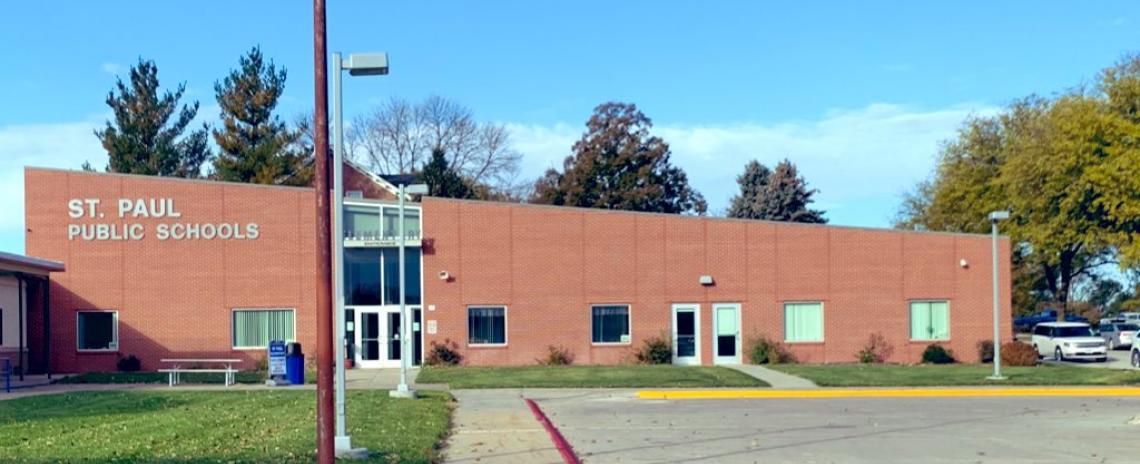The Recovery Room: St. Paul Elementary shifts classroom climate with mindful innovation
The Recovery Room: St. Paul Elementary shifts classroom climate with mindful innovation
By Tyler Dahlgren
Just outside of St. Paul Elementary’s “Recovery Room”, on a billboard used for announcements encased in glass, there’s a message on display for all the school's students to see.

“Mental health is something I’m very passionate about, and I would say our high school principal is also passionate about the mental well-being of our students,” said Elementary Principal Sara Paider. “When kids aren’t mentally healthy, then nothing else really matters. You’re not going to get through. You’re not going to be able to teach them.”
The “Recovery Room” is, at first glance, unassuming. Stroll through the hallways and you just might miss it. But what’s goes on inside of the room, the effect its having on classroom climate in this rural Central Nebraska elementary school, is pronounced.

“We want teachers to teach and to get through lessons and content and materials so that we can achieve progression towards standards in achievement areas,” said Paider.
A year ago, classroom behavior was derailing that course. Some students, Paider and her staff noticed, were constantly acting out and distrupting class. Struggling socially, emotionally and with mental health. In turn, they were flipping classrooms upside down.
During a Multi-Tiered Systoms of Support (MTSS) meeting last December, the leadership team dove into data analysis, looking closely at three classrooms in particular that had been hampered significantly by classroom obstructions with mental health at the root of the cause.
“It was just glaring in the data, the amount of lessons that weren’t being completed in the areas of reading in math,” Paider said. “At that point, we said to ourselves, ‘We have to do something.’”
St. Paul didn’t have the resources to hire their own behavior interventionist or social worker, but they did have a forward-thinking administrational team which, as Paider likes to put it, is willing to build a plane while in mid-air.
“When you’re in a smaller district, you do have to be creative and innovative and you have to use what you have,” Paider said. “We started brainstorming.”
The Recovery Room was born. A place to cool down. A safe spot to find composure.
“The room itself is not a consequence,” said Paider. “It’s an opportunity to get back into a good place. These are all of our kids, but we need these kids to be in a good place so that our teachers can do their jobs and get those kids educated.”
A referral process, which had to be black and white, was implemented and adopted by the teaching staff. Communication was key. Paider made it a point to be very transparent with educators in the building. Their feedback was instrumental, as was their buy-in.
“We talked a lot, and one of the most common pieces of feedback from teachers was ‘Okay, but I still want to be able to build a relationship with these kids and I need to do that, so how does that look?’” she said.
They added a “Think Sheet”, which students fill out in the Recovery Room and review with the teacher before being able to re-enter the classroom. The worksheets are reflective, while at the same time influencing students to own their behavior. The end goal is for all students to be in the “Green Zone”.

A student isn’t automatically referred to the Recovery Room, which is supervised throughout the day, in true all-hands-on-deck fashion, by a revolving group of volunteers. Teachers are still expected to use all strategies.
Involving parents was something Recovery Room organizers tried to do right away. Feedback, so far, has been awesome, said Paider, both from parents with children who are receiving true help rather than instant discipline and parents of students no-longer learning distracted.
“We’ve gotten really positive feedback from both ends, and some really great conversations have come out of the Recovery Room that have opened our eyes to what some of these kids are going through,” she said.
Lesson progression is back to where it needs to be, too. Academically, St. Paul Elementary has already seen a boost. Teachers have been able to teach, though some still struggle to remove a student from the classroom.
“They tend to put that stigma on themselves, that they’re not being an effective teacher or they’re unable to manage their classrooms or their kids,” Paider explained. “We really have had a lot of conversations around this. We tell them ‘You’re not a counselor. None of us really are counselors, but you’re not a counselor. You’re here to educate kids. Your focus should be on the students who want to learn and are engaged. Let the Recovery Room staff handle the kids who aren’t.’”
Mental health is taken seriously in St. Paul. The district put its staff through 40 Developmental Assetts and Trauma-Informed Schools Training. The Recovery Room has helped everyone at the elementary in one way or another. Its taught some students empathy and put others in the right frame of mind to learn. To recover.
“As a principal, you can kind of start finding yourself spending 95-percent of your time on 5-percent of the population,” she said. “All of a sudden, my focus and attention was entirely on the kids who were really struggling, and I lost sight of all the wonderful, awesome things that were going on in my school because I couldn’t get out there and see it.”
Paider has had an opportunity to take a step back and look at her school through a broader scope, and she likes what she sees.
“The Recovery Room has been a big help, I think, for all of us.”



